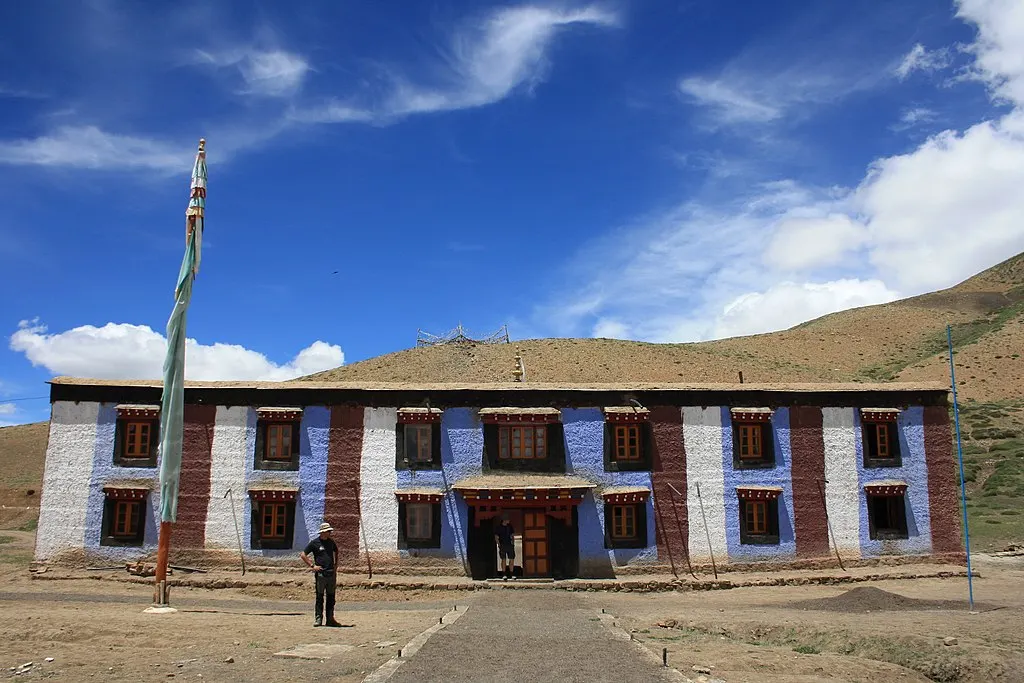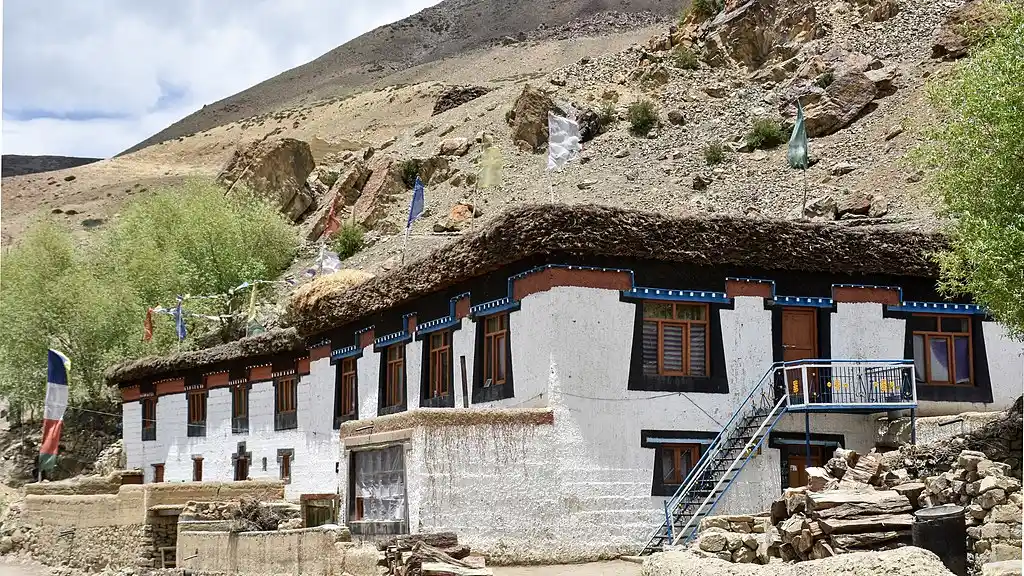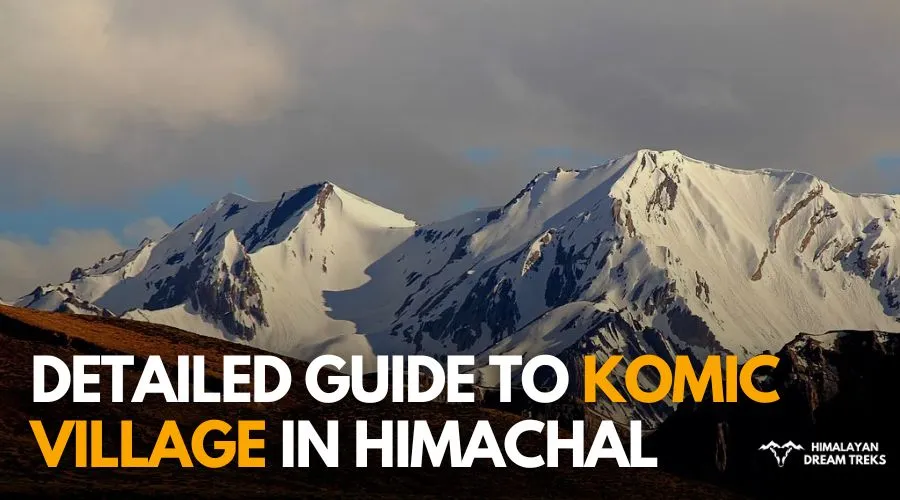Picture this: you are standing somewhere so high that you feel the clouds are below you, and the sky looks completely open and bright blue. This is real; this is Komic Village in the beautiful Spiti Valley of Himachal Pradesh. For every serious traveler and adventure lover in India, Spiti is a must-visit, and Komic is its most important spot. Why? Because Komic is famous as one of the highest motorable villages in the world.
Komic is more than just a place to visit; it’s an experience that can change your outlook. Forget about the busy hill stations; Komic gives you a huge feeling of accomplishment and quiet peace. This detailed guide is your simple way to understand the challenges of reaching this special Himalayan place. We cover everything you need: from the old history of the Komic Monastery to the important tips for dealing with the high altitude. Get ready for the highest journey of your life. If you want to see the natural, simple beauty of the Trans-Himalayas, then this Komic Village travel guide is what you need to read first.
Table of Contents
The Identity of Komic: Altitude, Monastery, and Heritage
A World Above the Clouds

The moment your vehicle stops in Komic, the first thing you will see is the large, famous signboard. The board clearly states that Komic is the World’s Highest Village Connected by a Motorable Road.
Komic is located at a huge height of about 4,587 meters (15,050 feet) above sea level. It truly feels like you are higher than most places people live on Earth. This height affects everything here: the thin air, the toughness of the local families, and the special, old architecture built to handle the coldest weather. The fact that a road even reaches this spot shows the amazing effort of building in the Himalayas. Because it is so high, getting used to the altitude is very important. We will cover this detail later, but for now, just know that you are standing very close to the top of the world!
The Meaning Behind the Name: Ko-Mik
The name Komic is not random; it has a beautiful, deep meaning in the Spiti Bhoti language and local stories. The name is made of two local words: ‘Ko’, which means ‘Snowcock’ (a large, high-flying Himalayan bird), and ‘Mik’, which means ‘Eye’. So, Komic means ‘The Eye of the Snowcock’.
The stories say that long ago, Buddhist monks, maybe when they were starting the monastery, saw this high, hidden spot. From certain views, the shape of the land and how the monastery sits among the large, dry land looked exactly like the keen eye of the snowcock.
Tangyud Monastery: The Spiritual Fortress of Komic
The main spiritual center of Komic is the Tangyud Monastery, often called Komic Gompa or Lundup Chemmo Gompa. This is one of the highest and oldest monasteries in all of Spiti Valley, making it a very important location for Buddhist tourism.


Historical Significance: The monastery was started in the 14th century and belongs to the respected Sakya sect of Tibetan Buddhism. Local stories say that the monastery was first built lower down near Hikkim Village. But because of natural problems or spiritual reasons, the monks moved it to this very high, safe location in Komic. This move showed their strong faith against the harsh weather.
Architecture and Atmosphere: The monastery’s building style is unique. It looks like a strong, old fort, built with thick, sloping mud and stone walls. This design helps it stand strong against the strong, high-altitude winds and earthquakes. Inside, the prayer hall is full of Buddhist art. You can see very old wall paintings, precious thangkas (religious scroll paintings), and holy books that are hundreds of years old.
The main figure here is often the Maitreya Buddha (The Future Buddha), who is believed to protect the villagers and the valley. Spending time inside the Gompa, watching the monks chant, and smelling the calming scent of juniper wood and butter lamps is an experience of pure peace.
The People of Komic
Komic is not just a high place; it is a living example of how strong people can be. The village has a small community of only about 10-15 families. Their culture is deeply connected to Buddhism and the tough Himalayan environment.
The Life of the Locals
The people of Spiti have learned to survive in one of the most difficult places on Earth.

- Architecture: Their houses are built the traditional way using mud, stone, and wood. The thick walls and small windows are specially designed to keep heat inside, making the rooms surprisingly warm even when it is freezing outside.
- Farming: They only grow one main crop each year, which is barley, during the short summer. This barley is used to make sattu (roasted flour) and the local drink, chhang.
- Festivals: If you visit during festivals like Losar (Tibetan New Year), you might see the Cham Dance (Mask Dance). This old, colorful dance is performed by the monks and shows the victory of good over evil, giving you a beautiful look into their spiritual world.
Best Time to Visit Komic
It is in the Trans-Himalayan Cold Desert region. This means it gets very little rain but heavy snow. This creates the stark, huge, and mostly barren landscape that makes Spiti so famous.
The Cold Desert Landscape and Fossil Heritage
The land around Komic, Langza Village, and Hikkim Village is not just beautiful; it hides a deep secret about Earth’s history. Millions of years ago, all this land was underwater in the ancient Tethys Sea. This is why the area, especially near Langza, has many sea fossils, like Ammonites. The land is rocky and raw, a perfect setting for the small fields where local Spitian farmers manage to grow basic crops like barley during the short summer.

Best Time for Komic: May to October
The time when you can easily visit Komic is quite short. The best time to visit Komic Village is generally from late May to early October. During these months, the mountain passes, which are the only ways into Spiti, are usually open, and the weather is good enough for tourists.
- Summer (Late May to June): The roads have just opened, and the weather is pleasant during the day, around 15 to 25 degrees Celsius. Nights are still cold, around 5 degrees. This is good if you don’t like very cold weather.
- Monsoon (July to Mid-September): Spiti itself does not get much rain, but the roads leading to it (from Manali or Shimla) get a lot of rain. Landslides and road closures are common in Kinnaur and Manali, which can cause long delays. However, the weather inside Spiti is good, with daytime temperatures between 10 and 20 degrees Celsius.
- Autumn (Late September to Early November): Many people think this is the most beautiful time. The sky is very clear, which is perfect for taking photos and seeing the stars. The roads are mostly dry, and the clear weather is a nice contrast to the brown mountains. It gets cold very quickly, though, so pack very warm clothes.
Seasons to Avoid: The Ultimate Winter Challenge
- Winter (Mid-November to April): Komic Village becomes almost impossible to reach. Temperatures drop far below freezing, often hitting -20 to -30 degrees. Heavy snow blocks the high passes like Kunzum and the Manali routes, cutting off the valley. Unless you are an expert winter trekker, it is best to avoid this period. The extreme cold is dangerous, and there are almost no places to stay.
Places to Visit Before Kaza
Reaching Komic is part of the legendary Spiti Valley Road Trip. Komic can only be reached by road, and you must get to Kaza first. Since the route from Manali often involves very sudden altitude changes, the Shimla-Kinnaur route is highly recommended because it helps your body adjust slowly. The start of this journey is important, and there are some essential stops you should plan for before the road gets very difficult.
Shimla, The Preparation Hub
Shimla (about 2,200 meters) is often the starting point for the Kinnaur-Spiti route. It is a big city and a good place to prepare.
- Last Chance for Supplies: This is your final stop for buying any complex items like cameras, specialized trekking gear, or important medicines that you might not find later on the route.
- Fuel and Checks: Make sure your vehicle is completely refueled and check your tire pressure and general condition. The next fuel stations are far apart and unreliable.
- First Acclimatization: Though not high altitude, spending a night in Shimla helps you get used to the initial height gain before the real ascent begins.
Theog
Just a short drive from Shimla, Theog (about 2,400 meters) is one of the first quiet towns where you start to feel the real mountain life.
- Quiet Charm: Unlike the busy Shimla, Theog offers a much quieter atmosphere. It is surrounded by thick forests and is known for its beautiful views and clear air.
- Apple Country: This area is famous for its apple orchards. If you travel during the harvest season (late summer/early autumn), you will see the valleys covered in red and green fruit.
- Altitude Gain: Theog gives you a gentle climb in altitude, which is important for starting the acclimatization process smoothly.
Narkanda, The Viewpoint and Gateway
Narkanda (about 2,700 meters) is a critical stop, and many travelers choose to spend their first night here after leaving Shimla. It marks the true start of the Kinnaur route.
- Hatu Peak Views: Narkanda is famous for Hatu Peak, which is a nearby mountain top. The views from here of the surrounding Himalayan ranges are amazing and wide. Visiting Hatu Peak is a popular side trip.
- The Real Mountain Drive: After Narkanda, the roads change significantly. The traffic becomes much less, and the roads become winding and more challenging, taking you quickly into a much higher mountain environment.
- Necessary Overnight Halt: Staying a night in Narkanda is highly recommended. The altitude is high enough to prepare your body for the much higher ground you will cover the next day as you move towards Kinnaur and then Spiti.
Moving Deeper into the Himalayas
From Narkanda, the road continues towards the Spiti Valley. You will pass through towns like Rampur, which is lower in altitude and warmer, and then start the long climb through Kinnaur, stopping at places like Sarahan (famous for the Bhimakali Temple) or Sangla (in the scenic Baspa Valley), before reaching the dry cold desert areas like Nako and Tabo on the final approach to Kaza.

How to Reach Komic Village: Final Road Trip
Reaching Komic requires you to first arrive at the main hub of Spiti Valley, Kaza.
Base Camp: Kaza, The Hub of Spiti
Kaza is the main town and center of Spiti. It is the necessary stop for filling fuel, finding a place to stay, and most importantly, getting used to the high altitude.
- Distance from Kaza to Komic: About 18 to 20 kilometers.
- The Journey: The road from Kaza to Komic goes uphill for a long time. It is narrow, very steep, and mostly dirt road, with rough patches and sharp turns. Although it is difficult, the views of the Spiti River below are stunning.
The Two Major Routes to Kaza
Travelers in India usually choose one of two main high-altitude routes to reach Kaza:
Route 1: The Manali Gateway (via Atal Tunnel), The More Common Choice
This route is often chosen by people who do not have much time or who start their trip early in the season, as the Manali side opens sooner.
- Path: Delhi/Chandigarh to Manali to Atal Tunnel to Keylong to Jispa to Batal to Kunzum Pass to Losar to Kaza.
- Highlights: The Atal Tunnel makes a big difference here, as it avoids the difficult Rohtang Pass, making the journey much faster and safer. You still have to cross the high Kunzum Pass (14,931 ft), which is usually open from June/July to October.
Route 2: The Kinnaur Gateway (via Shimla), The Route for Acclimatization
This is the traditional, longer, and more scenic route. It is suggested for better altitude adjustment because the climb is slow and spread out over many days, passing through towns like Shimla, Theog, and Narkanda as mentioned above.
- Path: Delhi/Chandigarh to Shimla to Narkanda to Nako to Tabo to Dhankar to Kaza.
- Highlights: This path takes you through the beautiful Kinnaur Valley and includes very challenging road sections. You see the landscape change slowly, which makes the shift to the cold desert easier on your body. This is also the only route that sometimes stays open into the deep winter (up to Kaza), though the road to Komic will always be closed.
Stay and Food in Komic: Embracing Spitian Hospitality (Homestays)
Komic does not have luxury hotels. Tourism here exists because of the helpfulness and kindness of the local people.
- Cuisine: The food is simple, tasty, and made from local ingredients. Expect food like Thukpa (noodle soup), Momos, Tingmo (steamed bread), Dal Chawal (lentils and rice), and local dishes made from barley and potatoes. Make sure to try the savory Butter Tea, which helps keep you warm.
- Cash is King: There are no ATMs in Komic, and even Kaza has few that often run out of cash. Mobile payment apps do not work reliably because of network issues. Carry enough cash for your entire trip in Komic and Spiti.
- The Homestay Experience: The few houses in Komic operate as basic, comfortable Homestays. Staying here is the best way to see the real Spitian culture. You sleep in warm, mud-brick rooms, often heated by a bukhari (a traditional stove). It is not about fancy service; it is about real warmth. You can check the following:
- Komic Monastery View Homestay
This homestay is a popular choice because of its location, offering guests a clear view of the historic Tangyud Monastery right from the windows or the small courtyard.
Location: It is situated on the eastern, higher side of the village, closest to the Gompa boundary. Like other local homes, the rooms are simple, built with thick mud walls that keep the interior warm against the extreme cold.
Price Range: You can expect this homestay to be in the standard range of INR 1,000 to INR 1,500 per person per night, often reflecting the premium view.
- The Highest Village Homestay
As the name suggests, this accommodation emphasizes the feeling of staying at the world’s highest accessible spot.
Location: This homestay is found near the entrance point to Komic, often situated right next to the PWD signboard area, giving it the literal “highest” claim.
Price Range: Prices are typically in the standard range of INR 900 to INR 1,400 per person per night, including two meals.
- Jordan House Homestay
Jordan House Homestay is often one of the first names visitors hear when looking for a place to stay in Komic. It is known for its reliable hospitality and friendly family atmosphere.
Location: This homestay is generally located slightly below the main village cluster, often closer to the dirt track access road leading up from Langza, offering easier accessibility compared to homes deep inside the settlement.
Price Range: This is generally considered a budget-friendly option, costing around INR 800 to INR 1,100 per person per night with meals.
4. Spitian Family Homestay
Choosing a Spitian Family Homestay means prioritizing the cultural exchange over modern amenities.
Location: This name represents any home situated within the heart of the village’s small residential section. This is a very immersive experience where you live alongside the family and share their daily routines.
Price Range: Due to the immersive, non-commercial nature, prices are set by the hosts, usually ranging from INR 900 to INR 1,300 per person per night, reflecting local rates for food and lodging.
Mobile Connectivity
- Network Status: Phone signal is either very weak or does not exist at all. While BSNL used to be the best, Airtel and Jio have better coverage around Kaza now. However, at the height of Komic, you cannot rely on any network.
Conclusion: The Highest Journey of Life
Team Himalayan Dream Treks regularly organizes Himachal village tours and the Spiti Circuit. You can check our offerings or contact us directly at info@himalayandreamtreks.in
Komic Village, the celebrated highest motorable village in the world, is much more than just a spot on the map. It is a journey into the soul of the Himalayas, a challenging drive that rewards you with views that are truly special. From the old history of the Tangyud Gompa to the simple joy of experiencing life in one of the world’s most remote villages, the trip to Komic captures the best of Spiti Valley travel.
It is a place that will test you, calm your mind, and stay in your memory forever. If the mountains are calling you, and you are ready for a trip that is physically tough and spiritually rewarding, then pack your bags and go to Komic. This journey will be unforgettable.

Leave a Comment